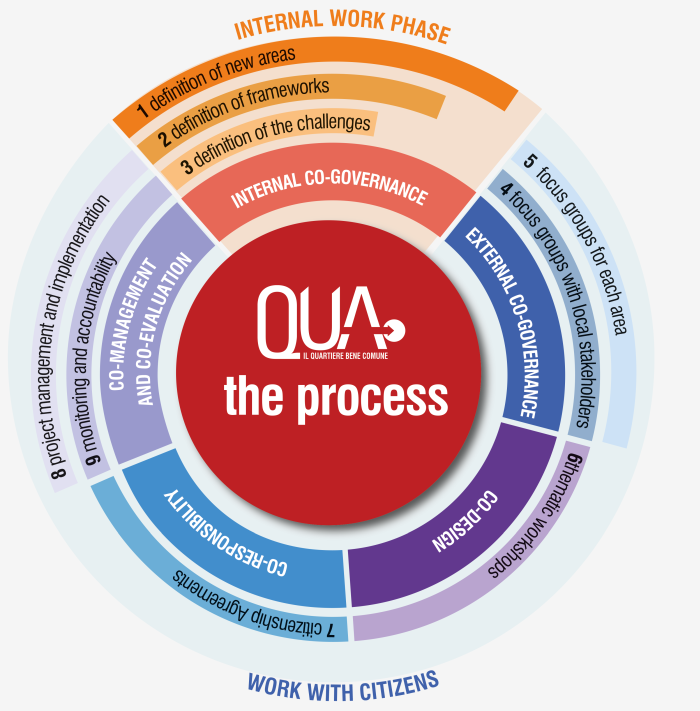The city as a common good - English version
Quartiere bene comune is a collaborative city project in which the relationship between the administration and the community is based on the sharing of objectives and projects to achieve them, starting with the neighbourhood as a place of identity. It takes the form of a partnership, i.e. a formal agreement, in which all actors are co-responsible for the innovation and improvement results decided together. The aim is to develop and overcome traditional models of service organisation and the public-private relationship, introducing the opportunity for communities to self-organise responses to their needs, strengthening proximity, alliances of purpose, identity and sense of belonging as conditions for a more sustainable and inclusive development.
How it works

Launched in 2015, as a response to the failure of the decentralisation model based on Circumscriptions, the project led in its first phase (2015-2019) to the signing of 27 Agreements with over 730 subjects, giving rise to 160 social innovation projects in different neighbourhoods and in different areas of public policy. With these projects we have responded to the needs of almost 14,000 users.
The intervention model is based on the adoption of a collaborative protocol, a process of dialogue and confrontation with communities to share the entire life cycle of a project: listening to identify needs, co-design and co-management of the solution and, finally, shared evaluation of results and impacts.
The neighbourhood architect
The reference figure for the management of the collaborative process is the neighbourhood architect: a referent of the municipality who is entrusted with the task of generating urban innovation projects, supporting and reinforcing relational networks in the neighbourhoods, and guaranteeing continuity of relations with the services of the authority. For each area, there is a reference neighbourhood architect.
After the pandemic
In 2020, the pandemic partly changed our intervention model.
First of all, we had to work online, which was the only way to keep the dialogue with communities and neighbourhoods alive, with respect to the situation we were experiencing and the related needs. We created a survey "Reggio Emilia, how is it going?", administered in the period April-June 2020 and in which more than 5,000 citizens participated.
In addition, we drew maps of the resources in the neighbourhoods: the atlases, produced thanks to the collaboration of all the services of the Municipality, tell us today what there is in the areas in terms of opportunities but also of weaknesses and risks.
The survey and analysis of the data and atlases enabled us to identify three main lines of action:
Spaces and Parks as Common Goods - four workshops, in line with the recent regional urban planning law, dedicated to new ways of using and/or temporarily using common public spaces and properties. The commons on which we are working are Villa Levi, the green area of Via Cugini, Palazzo Vecchio al Mauriziano, and the courtyard of the Reggia di Rivalta.
Community spaces and networks - creation of networks of associations that collaborate in the co-design of innovative services for the communities of the neighbourhoods: social and intercultural inclusion, education and citizenship, digital literacy, sport and free time, sociality and territorial animation as innovative ways of interpreting proximity as a new unit of measurement for opportunities, services and neighbourhood networks.
Neighbourhood greenway and parkway - Reggio Emilia, city of trails is the title we have given to strengthen the infrastructure for cycling and walking, including hiking trails and becoming the city with the highest number of hiking trails in the urban area. The project, which is also the result of the 2021 edition of the Emilia-Romagn Region's call for participation, sees the collaboration, from the very beginning, of an institutional partnership made up of other bodies: the Italian Alpine Club (Cai), Fiab Reggio Emilia, the Central Emilia Land Reclamation Consortium, Uisp Reggio Emilia, the Central Emilia Parks Authority, the Central Emilia WWF and Istoreco.
Within these strands we are building partnerships and collaborating with communities to implement individual urban innovation projects through which we aim to build a sustainable and inclusive city model. In our collaborative work, we address the challenges of the neighbourhood as well as those of the city: how to improve mobility, how to improve services for vulnerable groups, how to care for the land or how to improve infrastructure and digital skills. We can do a lot to improve life in our neighbourhoods, in different areas. Because citizens, associations, businesses, schools, research and knowledge institutions are competent and decisive players in creating the city as a common good, becoming protagonists of projects capable of providing answers to different types of problems or needs.
We are looking for the right ideas, passion and spirit to realise them. Read about current projects.
